Antique textiles may face deterioration over time, becoming brittle and fading in colour. However, this can be reduced and avoided through careful cleaning techniques and correct environment conditions. This caring for antique textiles guide provides top tips from our expert conservators, so that you may keep your upholstery and other textile items in good condition for years to come.
 Above: a selection of antique textiles including a Victorian sampler, Korean hierarchy badge, and an 18th century embroidery
Above: a selection of antique textiles including a Victorian sampler, Korean hierarchy badge, and an 18th century embroidery
Handling antique textiles
If textiles are handled with bare hands, oil, salts and dirt from the skin can be transferred onto the fibres. This can lead to deterioration and weakening of the textile over time. Clean cotton gloves should be worn when handling textiles to avoid this. In special cases where the textile is particularly fragile the need for increased sensitivity of touch may supersede the need for wearing gloves. If this is the case, make sure hands are washed and dried thoroughly before handling and remove any rings or bracelets which may catch on the fabric.
 Above: a gold Dutch embroidery of the the Annunciation for an altar frontal or orphrey, 15th century.
Above: a gold Dutch embroidery of the the Annunciation for an altar frontal or orphrey, 15th century.
Textiles can easily be damaged if they’re stored or transported inappropriately. If the textile is small enough, lay it on a board or tray to move it around, this is safer than holding the textile by the edges and carrying it unsupported. Small pieces should be stored flat, without folding or creasing the fabric.
The best way to store large textiles is by rolling them around a sturdy round tube, the wider the better. Cover the tube with a layer of stable polythene or acid free tissue or paper, and if possible also put an interleaf of acid free tissue on the textile before rolling to separate the layers. Lastly, cover the textile roll with an inert material such as archival polyester and polythene materials.
 Above: examples of antique textiles including 17th century bishops gloves, 15th century embroidered medallion, a needlework miniature of Charles I by Wenceslaus Hollar, 14th century embroidered purse, and a late 18th century fan
Above: examples of antique textiles including 17th century bishops gloves, 15th century embroidered medallion, a needlework miniature of Charles I by Wenceslaus Hollar, 14th century embroidered purse, and a late 18th century fan
Environmental conditions for antique textiles
Textiles are very prone to damage from light exposure and most of the effects of this are irreversible. Coloured dyes can fade quickly and white areas can turn yellow if light levels are not controlled. Extensive exposure also weakens the fibres and makes them brittle. This can lead to the fibres breaking and the textile falling apart.
The recommended light level for long term display of textiles is 50 lux, which may be achievable in museums, but may be difficult in the home. Light exposure is cumulative, which means it builds up based on light levels and length of exposure.
 Above: a close up of Kimono silk printed with a pattern of peonies and birds, early 20th century
Above: a close up of Kimono silk printed with a pattern of peonies and birds, early 20th century
Overall exposure can be levelled out by having higher light levels for periods and lower light levels for the rest of the time. Ways to reduce this include closing blinds or curtains when the room isn’t in use, displaying textiles on walls which don’t get direct sunlight, and reducing UV either with a filter on windows, bulbs or UV filtered glazing if the textile is framed.
Textiles are extremely hygroscopic and absorb water from the surrounding air very easily. When the relative humidity in their environment fluctuates, the fibres expand and shrink accordingly. Large fluctuations in short periods can put stress on the fibres and contribute to the weakening of the textile.
In low humidity fibres can become brittle and more prone to physical damage. Silk and wool are the most at risk from moisture damage. Stable relative humidity levels around 45-60% are recommended for protecting textiles from damage.
 Above: a detail from a French tapestry wall hanging with damage to the face of the central figure, 17th century
Above: a detail from a French tapestry wall hanging with damage to the face of the central figure, 17th century
Some areas in a room are more likely to have humidity and temperature fluctuations, including external walls and areas near radiators and air vents, so if possible keep textiles away from these areas when displaying them. Also avoid storing them in attics or basements if possible as there is a higher chance of leaks, flooding and extreme humidity changes.
Relative humidity is also dependent on temperature, and somewhere in the range of 10 – 20°C will help control humidity and keep it stable. Temperatures on the lower end of the scale will help reduce insect and pest activity. Keeping humidity below 60% will also reduce the risk of mould and pests. Keeping the textiles and the area around them clean helps prevent pest attack from mice and rats, moths, silverfish, beetles, and insect larvae.
 Above: a hand painted Chinese silk panel for dress making or decoration, 18th century
Above: a hand painted Chinese silk panel for dress making or decoration, 18th century
How to clean antique textiles
Dust and airborne particles can sit on the surface of the fabric or get into the gaps between threads. If left for an extended period of time it can lead to degradation of the fabric and can attract pests.
Careful dusting and vacuuming every few months can help reduce the amount of dirt on a textile piece. Place a piece of mesh or netting with small holes over the textile, and make sure it’s held down and won’t move during cleaning. This will help stop any loose threads or fragile pieces being dislodged during cleaning. Use a vacuum with a low suction setting or hold the nozzle 15cm away from the textile, otherwise pieces may be pulled into the vacuum.
 Above: antique furniture with upholstery including a 19th century settee designed by Lawrence Alma-Tadema and a 18th century silk satin armchair
Above: antique furniture with upholstery including a 19th century settee designed by Lawrence Alma-Tadema and a 18th century silk satin armchair
Then, using a flicking motion, brush the dust from the textile up towards the vacuum with a round bristle brush.
Avoid areas with visible fraying and broken threads, and be careful of decorative beads or sequins as they may not be attached securely. It may be appropriate, depending on the piece and the way it’s displayed to remove it from the wall before cleaning. First though, make sure the surface it’s being moved to is clean.
 Above: a tapestry before and after being cleaned and restored by our textile conservator
Above: a tapestry before and after being cleaned and restored by our textile conservator
Displaying textile antiques
UV rays may fade or discolour the dye, visually disturbing and weakening the threads. Tapestries and wall art should be placed behind glass or framed to protect from sunlight, and should also be kept in shaded areas. UV protective framing options can be arranged by our team, including the use of UV proofing glass which offers 70-99% protection. Specialist film can also be placed on windows. For smaller objects or those with textile features, consider placing them in a cabinet away from a sunny location.
Textiles should also be professionally mounted to avoid the use of amateur adhesives which may contaminate, discolour and degrade the materials. The fabric should be set back from the glass and in a well sealed frame which will not trap moisture. For conservation approved framing methods, please contact our team who will be happy to help.
 Above: a selection of framed Victorian textile samplers, 19th century
Above: a selection of framed Victorian textile samplers, 19th century
Professional antique textile conservation
Signs of damage to look out for include breakages, staining, mould, and pest attack.
If your textile has fraying threads, loose pieces, tears, or other physical damage a conservator can stabilise and repair these areas. They can also clean any staining using specialised techniques to remove the discolouration without damaging the fabric.
 Above: a selection of textiles which have received conservation treatment from our team, including a military cap and a family heirloom, as well as wool tapestry and needlepoint artwork
Above: a selection of textiles which have received conservation treatment from our team, including a military cap and a family heirloom, as well as wool tapestry and needlepoint artwork
Mould presents as areas of fluffy growth and can stain textiles very easily. Different species of mould are different colours, mostly black, white and green but they can be any colour, so look out for any new random spots of colour. A conservator can stop the mould growth, remove spores, and reduce staining.
 Above: a silk artwork which was restored by our team following water damage and discolouration
Above: a silk artwork which was restored by our team following water damage and discolouration
Random holes with clean edges, small droppings or insect casings can indicate pest infestation. A textile conservator can treat textiles with pest damage and give advice on preventive measures to stop further infestations.
 Above: a military cap before and after restoration by our textile conservator
Above: a military cap before and after restoration by our textile conservator
Contact our team for further information
If you have an antique with areas of upholstery or other textiles, please contact our team as soon as possible when you spot signs of damage. This will help to reduce the damage and the intervention required.
You can email [email protected] or call 0207 112 7576.
You may also be interested in:

 Above: a selection of antique textiles including a Victorian sampler, Korean hierarchy badge, and an 18th century embroidery
Above: a selection of antique textiles including a Victorian sampler, Korean hierarchy badge, and an 18th century embroidery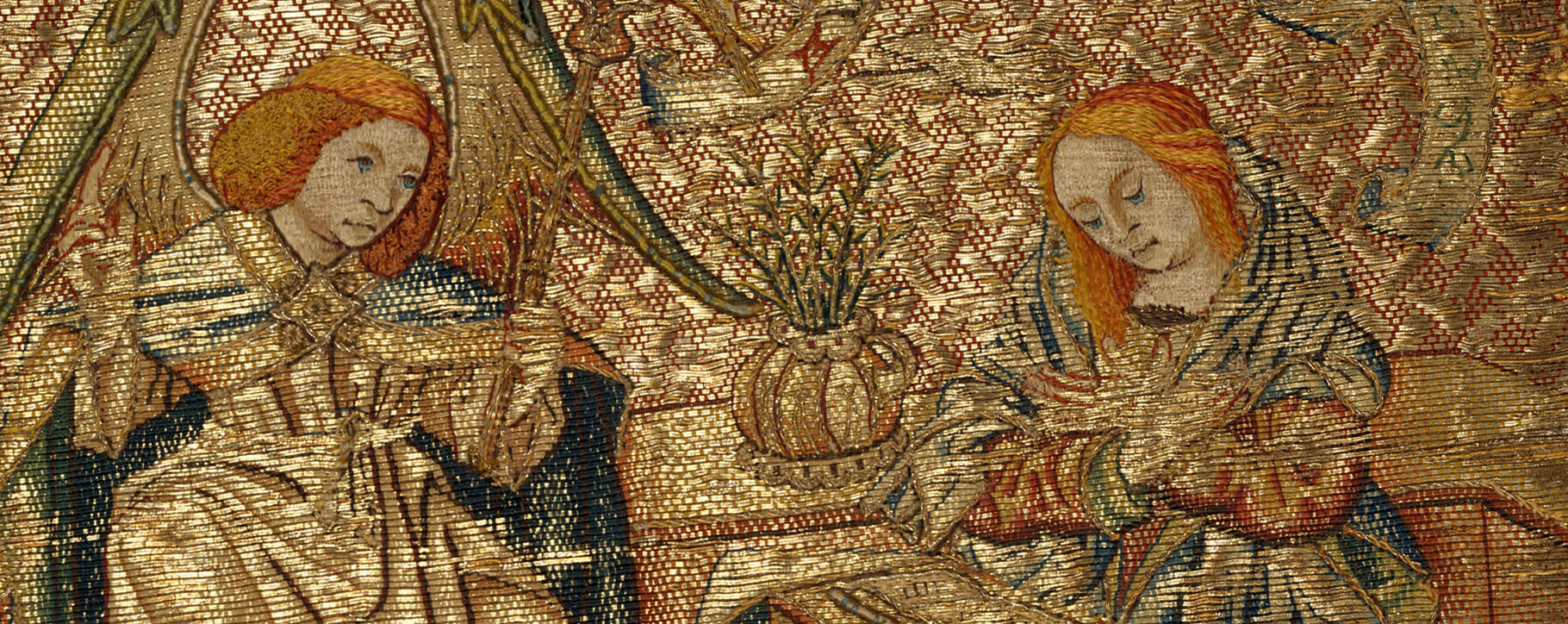 Above: a gold Dutch embroidery of the the Annunciation for an altar frontal or orphrey, 15th century.
Above: a gold Dutch embroidery of the the Annunciation for an altar frontal or orphrey, 15th century. Above: examples of antique textiles including 17th century bishops gloves, 15th century embroidered medallion, a needlework miniature of Charles I by Wenceslaus Hollar, 14th century embroidered purse, and a late 18th century fan
Above: examples of antique textiles including 17th century bishops gloves, 15th century embroidered medallion, a needlework miniature of Charles I by Wenceslaus Hollar, 14th century embroidered purse, and a late 18th century fan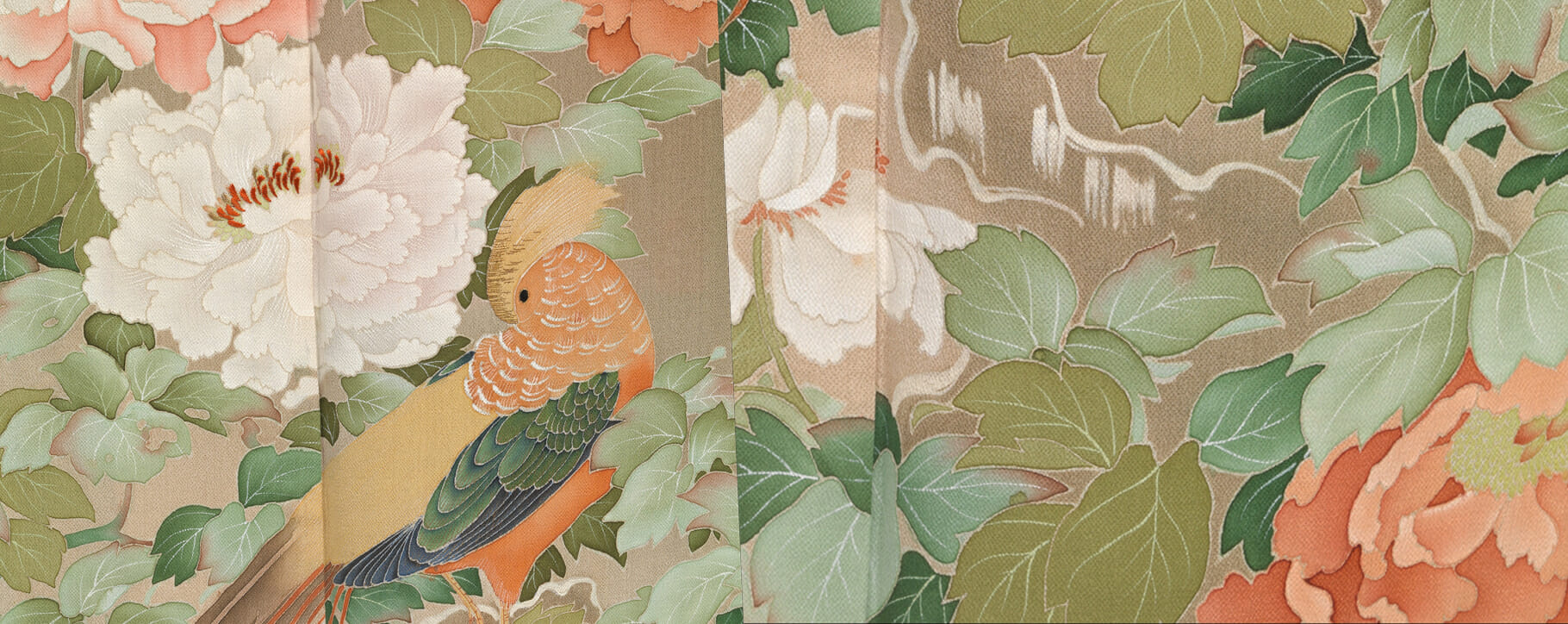 Above: a close up of Kimono silk printed with a pattern of peonies and birds, early 20th century
Above: a close up of Kimono silk printed with a pattern of peonies and birds, early 20th century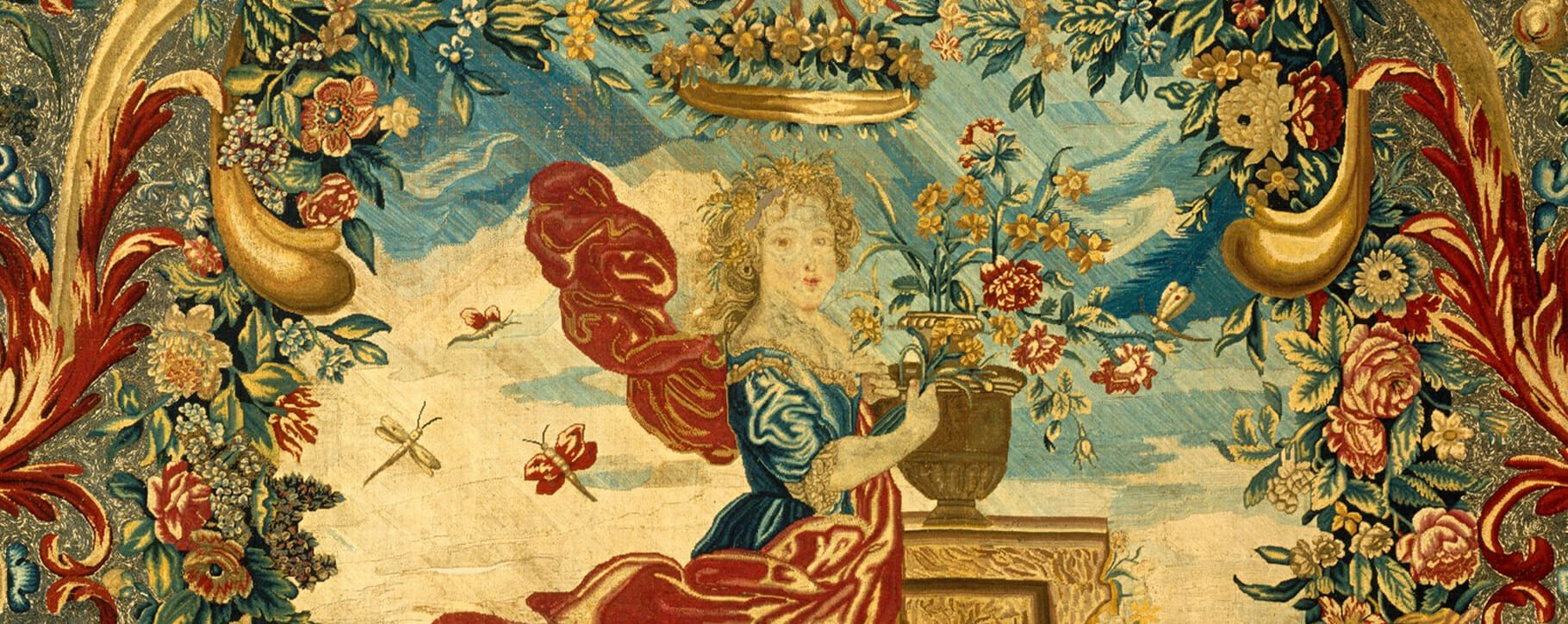 Above: a detail from a French tapestry wall hanging with damage to the face of the central figure, 17th century
Above: a detail from a French tapestry wall hanging with damage to the face of the central figure, 17th century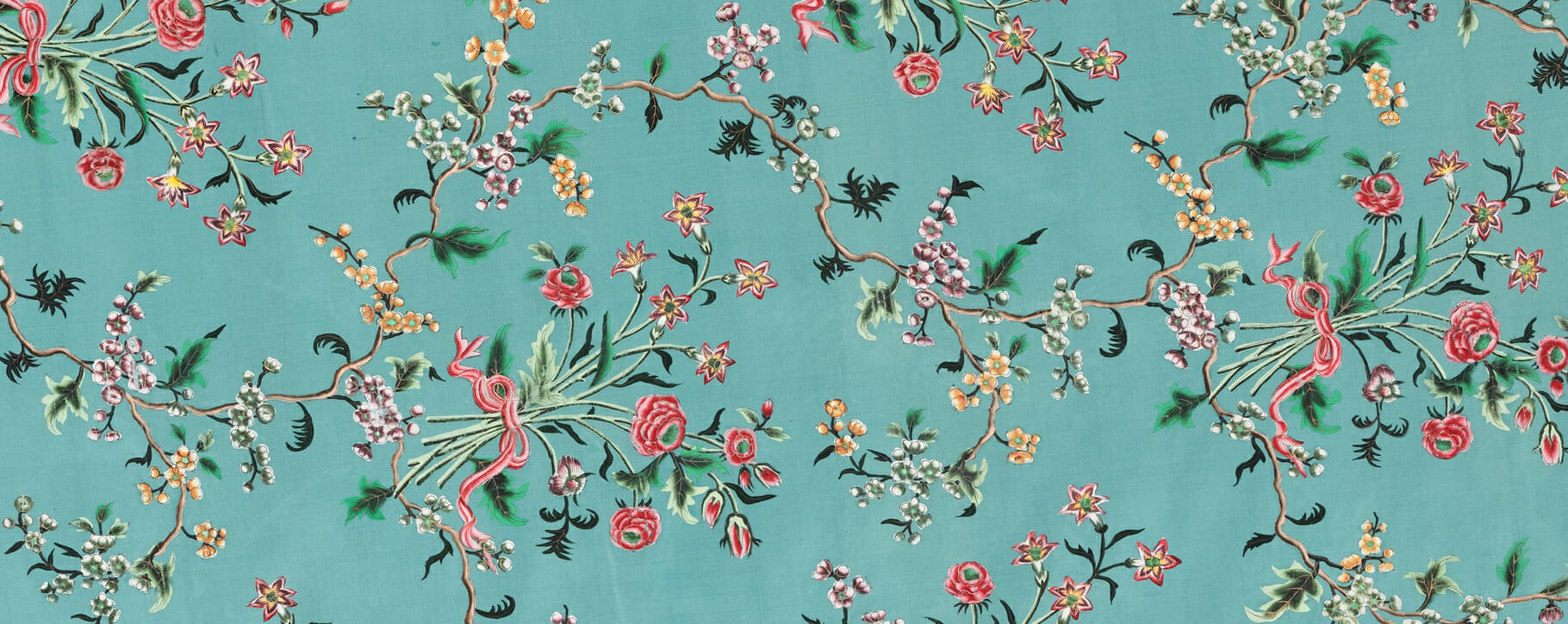 Above: a hand painted Chinese silk panel for dress making or decoration, 18th century
Above: a hand painted Chinese silk panel for dress making or decoration, 18th century Above: antique furniture with upholstery including a 19th century settee designed by Lawrence Alma-Tadema and a 18th century silk satin armchair
Above: antique furniture with upholstery including a 19th century settee designed by Lawrence Alma-Tadema and a 18th century silk satin armchair Above: a tapestry before and after being cleaned and restored by our textile conservator
Above: a tapestry before and after being cleaned and restored by our textile conservator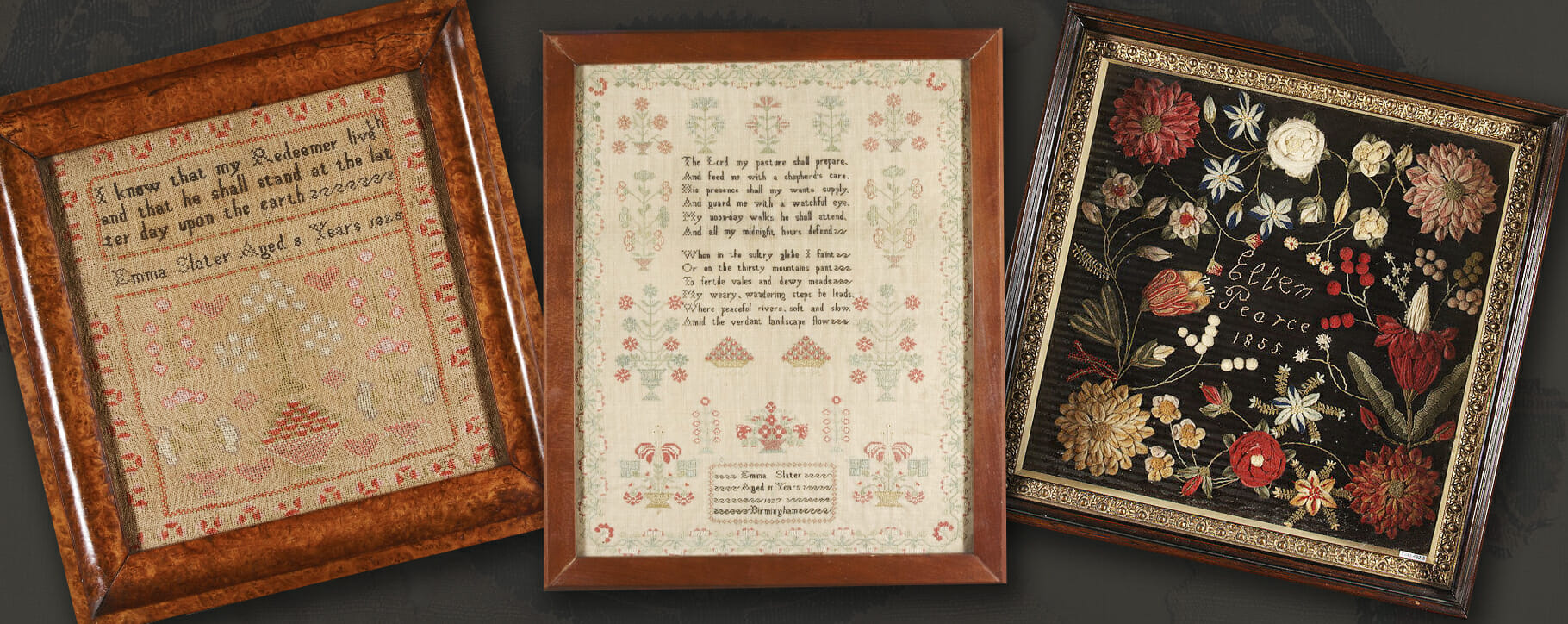 Above: a selection of framed Victorian textile samplers, 19th century
Above: a selection of framed Victorian textile samplers, 19th century Above: a selection of textiles which have received conservation treatment from our team, including a military cap and a family heirloom, as well as wool tapestry and needlepoint artwork
Above: a selection of textiles which have received conservation treatment from our team, including a military cap and a family heirloom, as well as wool tapestry and needlepoint artwork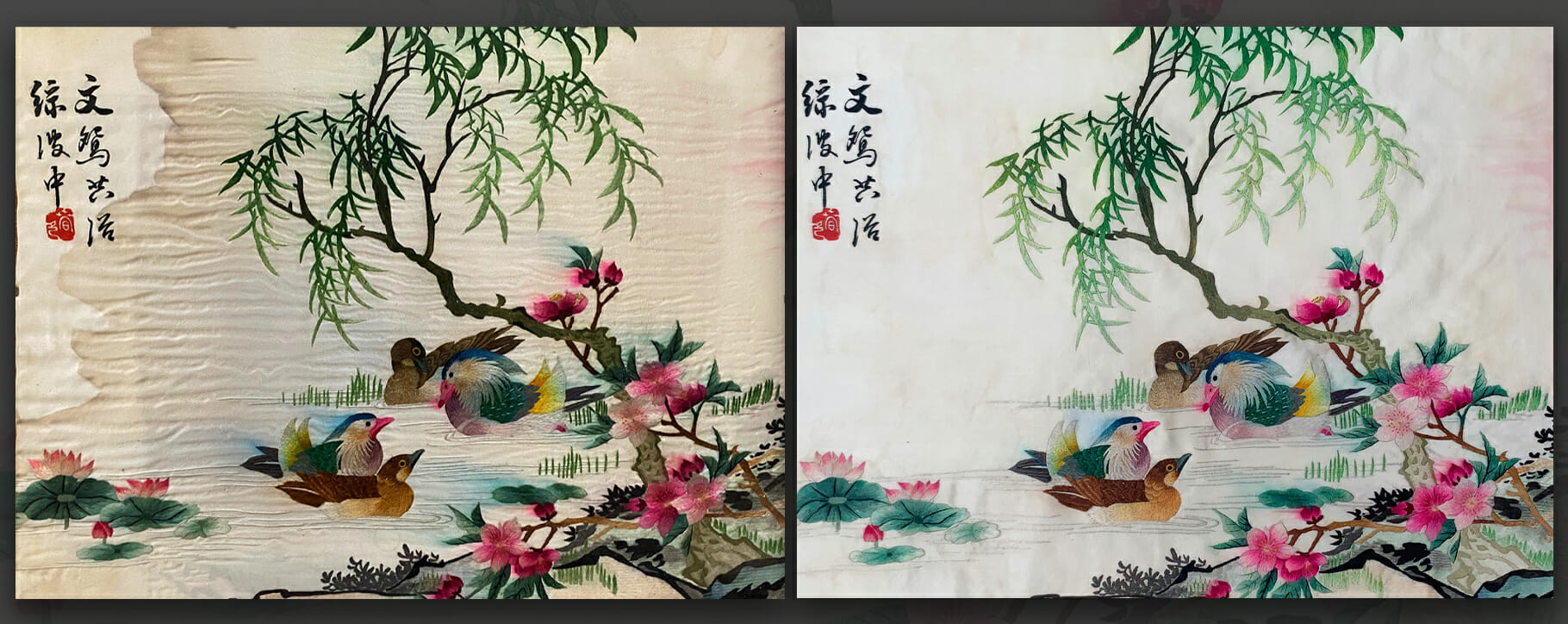 Above: a silk artwork which was restored by our team following water damage and discolouration
Above: a silk artwork which was restored by our team following water damage and discolouration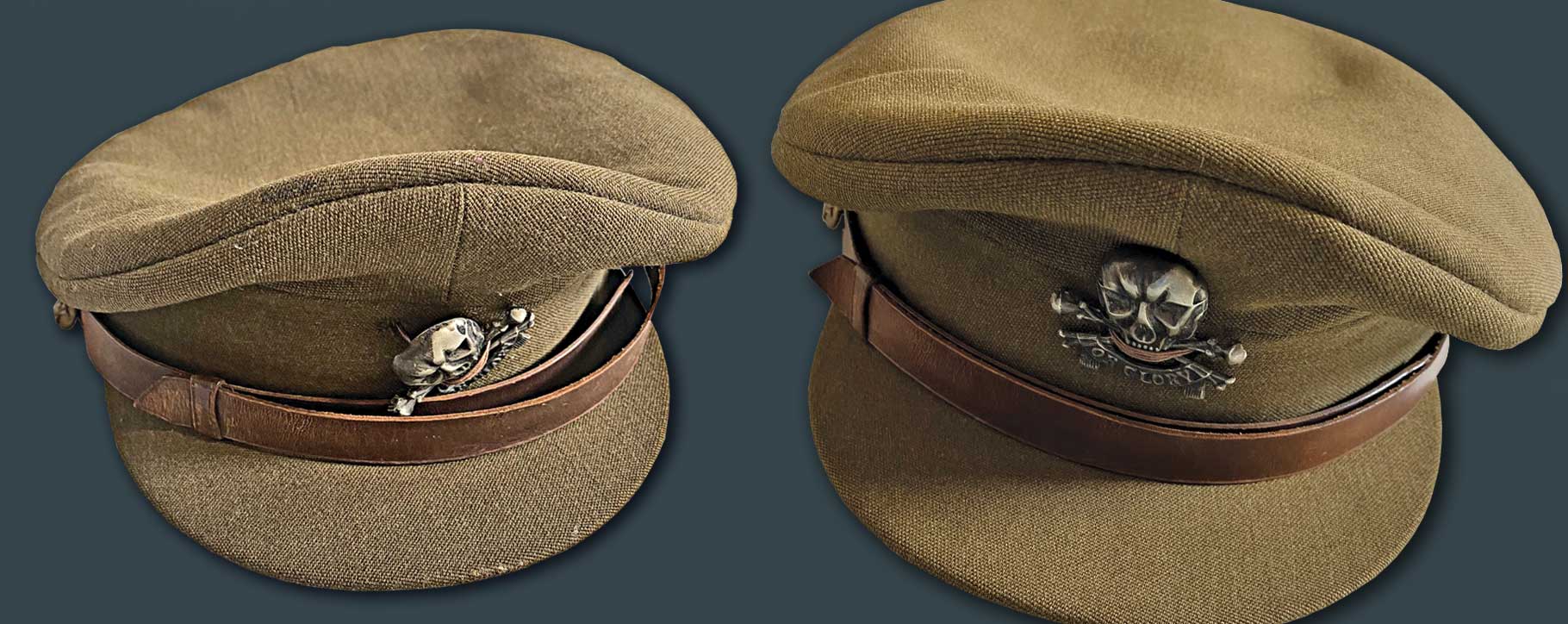 Above: a military cap before and after restoration by our textile conservator
Above: a military cap before and after restoration by our textile conservator




